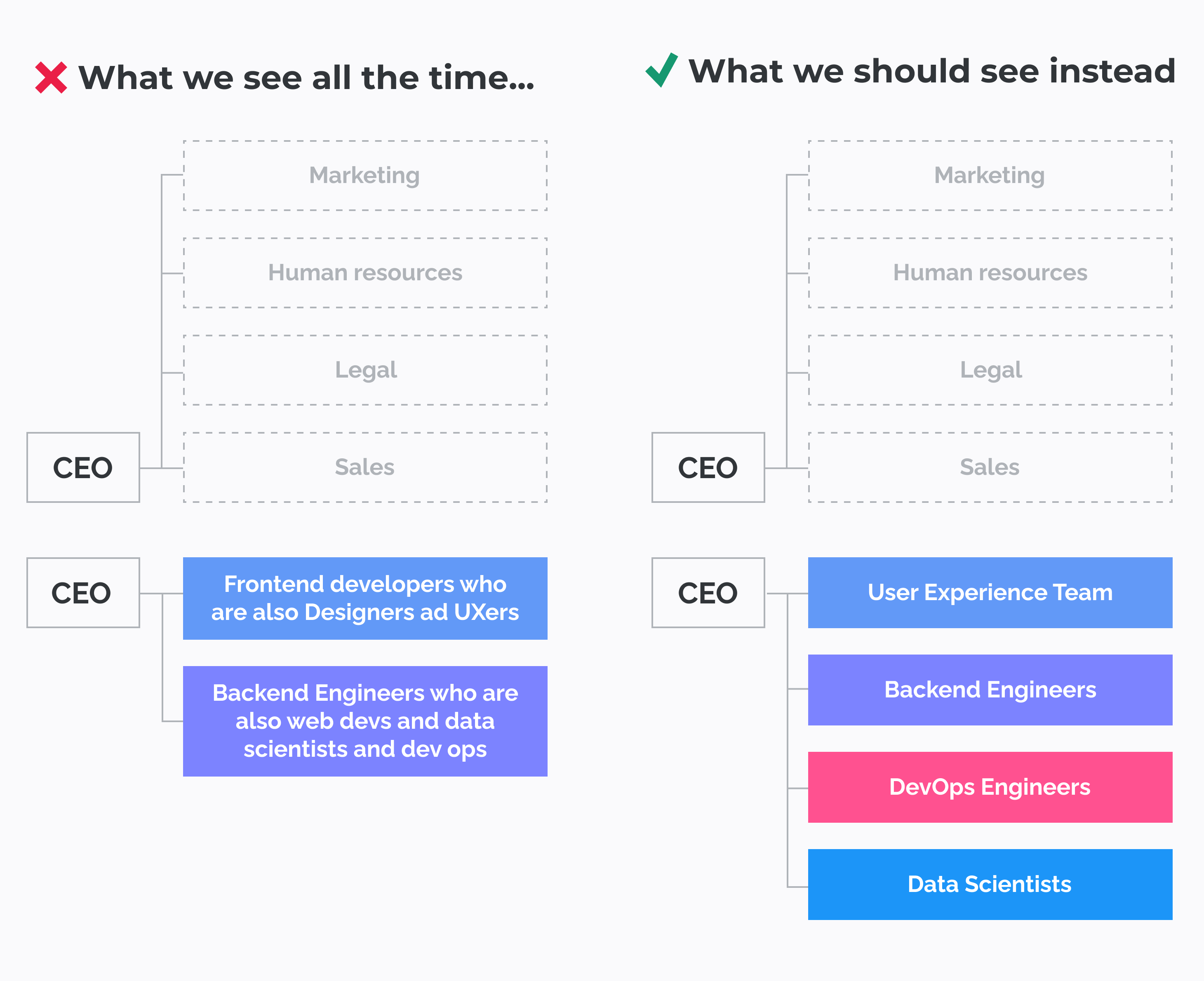Startup: Tech Company Organizational Structure

According to the CB Insight study, a reliable killer for startups is problems and inconsistencies within the team (23 percent). A vast majority of startups doesn’t understand that a clear org chart drives a company to success, that is why they die a chaotic death. We at Yojji understand that establishing the right structure is extremely important for increased productivity, proper communication, and smooth workflow. We’ve decided to share with you some ideas on what a startup team structure looks like and how to build a successful team. Let’s jump straight into these questions.
Tech Company Organizational Structure
 A startup team structure must be clearly outlined; each of the departments and experts has roles and responsibilities. Basically, there are two main roles atop of the software development team hierarchy - Founder, also known as Chief Executive Officer (CEO), and Chief Technology Officer (CTO). The founder is responsible for marketing and sales, legal issues, human resources, management, and supervising the CTO. The CTO also has certain areas of responsibility, they include managing the UX team, Backend team, DevOps team, and QA team. Below, we will consider a roles and responsibilities template in detail.
A startup team structure must be clearly outlined; each of the departments and experts has roles and responsibilities. Basically, there are two main roles atop of the software development team hierarchy - Founder, also known as Chief Executive Officer (CEO), and Chief Technology Officer (CTO). The founder is responsible for marketing and sales, legal issues, human resources, management, and supervising the CTO. The CTO also has certain areas of responsibility, they include managing the UX team, Backend team, DevOps team, and QA team. Below, we will consider a roles and responsibilities template in detail.
UX Team
User experience is one of the key indicators of product success, so working on this aspect of the project is vital. Users should get a perfect user experience and enjoy excellent usability, interesting design, and functionality. Oftentimes, the UX team consists of several experts who work together to achieve the set objectives. A typical UX team includes:
- Leader
- UX researcher
- UX designer
- Frontend developers
Each specialist has their own responsibilities. For example, a UX researcher analyzes user behavior, draws up a detailed report, then submits it to the UX designer who creates layouts taking into account all the user desires. The role of a researcher should not be neglected because he helps to create the design that will win the hearts of users and will contribute to the success of the project. Designers collaborate with developers who create the required interface, and the team leader organizes and coordinates their work.
Backend Team
This team is the core of the entire organization as it is responsible for the application logic, efficient code, and data structure. Most often, it consists of the following experts:
- Backend engineers
- Middle-stack developers
- Team leader
Engineers are engaged in coding, improving algorithms and application logic, but for the interaction between the back-end and the front-end sides, it is necessary to involve middle-stack developers. They handle cleaning user input, rest API endpoints, etc. Thus, developers will be able to focus on performing their job efficiently, without being distracted by third-party issues. All these issues will be handled by middle-stack developers. As in any other team, there is also a leader who organizes the workflow, assigns the tasks, and coordinates the work of all team members.

DevOps Team
DevOps team provides a flawless user experience, ensures the product goes to market, tests new versions of the product, and also manages the cloud infrastructure. Often, this team consists of a cloud architect, system administrator, site reliability engineer, and team lead.
The main task of a cloud architect is the creation and management of the cloud infrastructure; the site reliability engineer ensures the smooth operation of all necessary systems, the system administrator is responsible for maintaining the cloud, and the team lead distributes tasks and responsibilities within the team and controls the workflow.
QA Team
A successful product is always a high-quality product, that is why a quality assurance team is a must-have for any startup. Experts test the application, find bugs, send reports to the developers, who, in turn, fix these errors and ensure more efficient and stable application operation. QA team includes:
- QA Lead
- QA Analyst
- Testers
The most responsible role is taken by the QA lead, since this person sets the indicators of the quality standard, ensures that these standards are adhered to, determines the main strategies, manages the team, plans tasks, assigns responsibilities to specialists, and also monitors their work. The QA analyst creates test plans and executes them. Depending on the project type, timeline, budget, and customer requirements, you may need a manual QA specialist or an automation testing specialist who can perform manual testing if necessary.
Both types of testing are effective, but each of them has its own advantages and disadvantages, so it is up to you which option to choose. Regardless of the choice made, QA analysts create the necessary documentation and develop test scripts. The testers, in turn, execute the test scripts and report the results to the analyst and the QA lead.
Marketing team
Marketing experts promote your business and create an overarching image to portray your organization in a positive light. Typical responsibilities of a marketing team involve the following:
- It is engaged in brand management.
- Runs a marketing initiative campaign, identifies the core services or products for which sales cycles are launched.
- Creates content that promotes your service or product.
- Optimizes your organization’s website, creates content, and updates it regularly.
- Monitors and manages social networks.
- Organizes and manages internal communication.
- Collaborates with the media.
- Coordinates the work of third parties providing marketing support. For example, advertising and PR agencies, web providers.
Human Resources Team
The HR team should be one of the pillars of any startup because it hires new employees, develops them, and retains them. Here are the main functions of a structured HR team:
- Hiring employees
HR managers create accurate job titles and descriptions, conduct structures interviews, deal with legal issues, for example, various labor laws.
- Developing and retaining employees
Professional employees are crucial for business growth, that is why HR managers utilize various techniques to make sure your workers develop and work together to drive your startup to success. So, managers provide various benefits and fair compensations to workers, contribute to management training, create a favorable and strong workplace culture, and cultivate career paths once your startup grows.
Legal Team
This team makes sure your startup operates within the law. Thus, experts handle various business issues: tax planning, intellectual property issues, various arrangements, employment contracts, litigation.
Sales Team
In a startup, sales managers do more than just sell. In fact, in addition to lead generation, deal closing, and managing relationships with customers, they also adapt the sales process according to customer pain points (this process is also known as concept sales).
So, we’ve considered the structure of the project team, but how to form it? You will find the answer below.
How to Build a Startup Team?

There are various ways to form your team, and each of them depends on your priorities and goals. You can build your own in-house team, go for partial outsourcing, or choose complete outsourcing (a great option for lean startups). We will give an overview of these ways to help you make your choice.
- Full in-house team
This option allows you to easily manage a team, but keep in mind that in this case, additional costs await you: taxes, salary payments, operating costs.
- Partial outsourcing/staff augmentation
This model allows you to save money on the development, as it offers the ability to outsource work on certain tasks to third parties or expand an existing team.
- Complete outsourcing/dedicated development team
When using this model, you can significantly save money, since it allows you to hire a special team to perform all tasks.
Conclusion
Thus, understanding a company structure is not a daunting task when this structure is clearly outlined. Remember that assigned roles and responsibilities make a huge difference in how a company works. Defined roles will contribute to the more efficient operation without additional expenses, which is extremely important for startups. If you are looking for outsourcing or staff augmentation, our specialists are always ready to assist whenever it is necessary.

Yojji successfully delivered the project within schedule. They demonstrated excellent project management via weekly sprint demos and promptly made adjustments based on the client's feedback. Their responsiveness and collaborative attitude were key elements of their work.

5.0
Yojji was an instrumental part of the client’s team, working closely with them to achieve the product’s success. The team was very collaborative and timely, and their performance was amazing. Additionally, their resources were experienced, professional, and enjoyable to work with.

5.0
Yojii is impressive both in quality of development work as well as their commitment. Strong focus on delivery, highly technical personnel, flexible approach that allows for rapid development. Strong processes that allow for solid controls.

5.0
We’re very happy with the way that Yojji works, which is why we’ve spent so much money and engaged them for such a long time. We treat them as employees in regard to responsibilities and expectations, and they haven’t disappointed us.

5.0
As a company, we find Yojji to be excellent development partners - we cannot recommend them more highly and will be very happy to continue working with them in the future.

5.0
They are really nice people with excellent technical backgrounds.

5.0
We used Agile project management methodology and were in contact with the team and project manager daily.

5.0
They all had a super positive outlook and were dedicated to getting the work completed to a high standard.

5.0
Yojji has delivered an accessible product with thorough consideration for the client's requirements. Users have commented on the platform's user-friendliness and speed. Moreover, the team is easy to communicate with and provides frequent updates. Their development and design skills are impressive.

5.0





